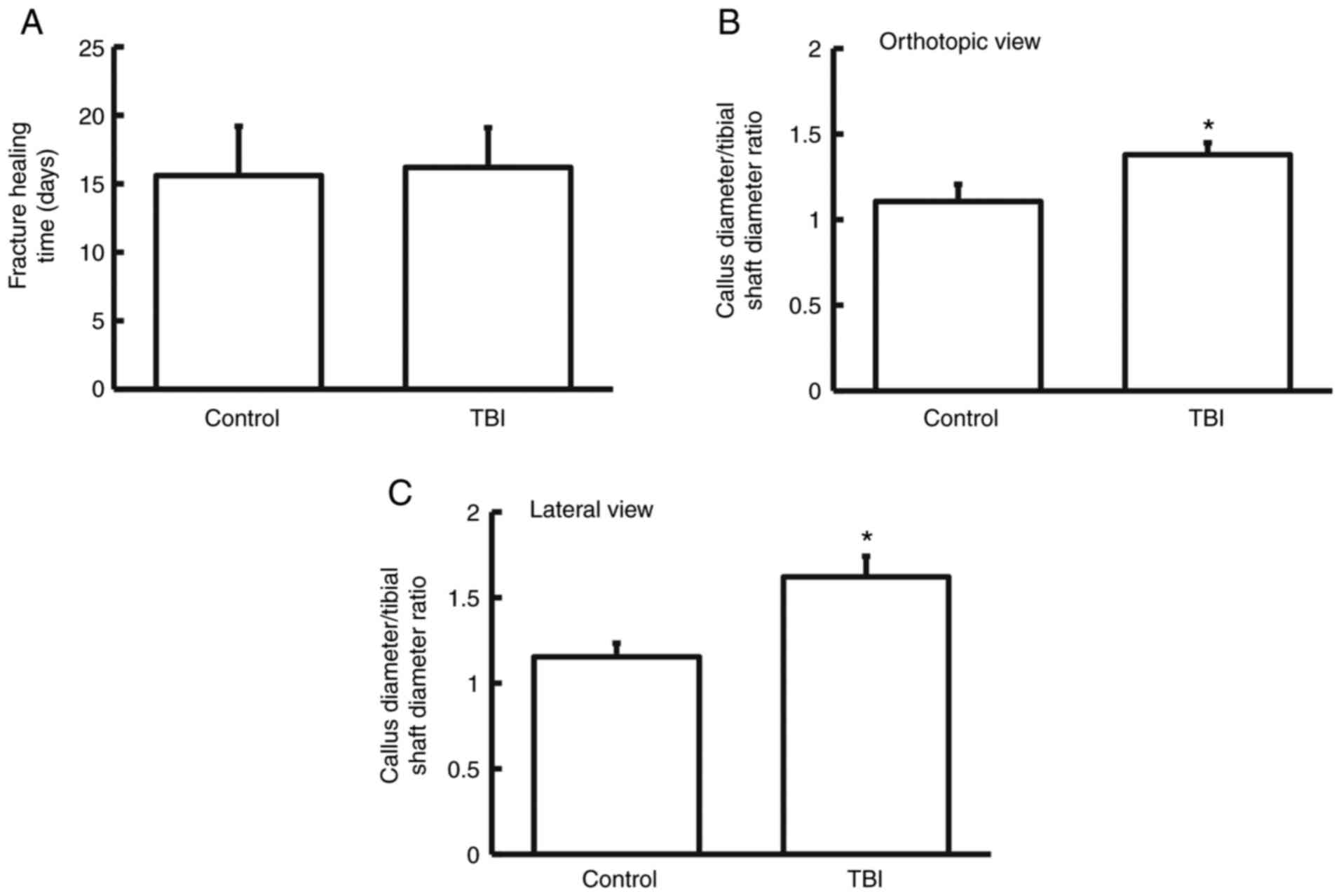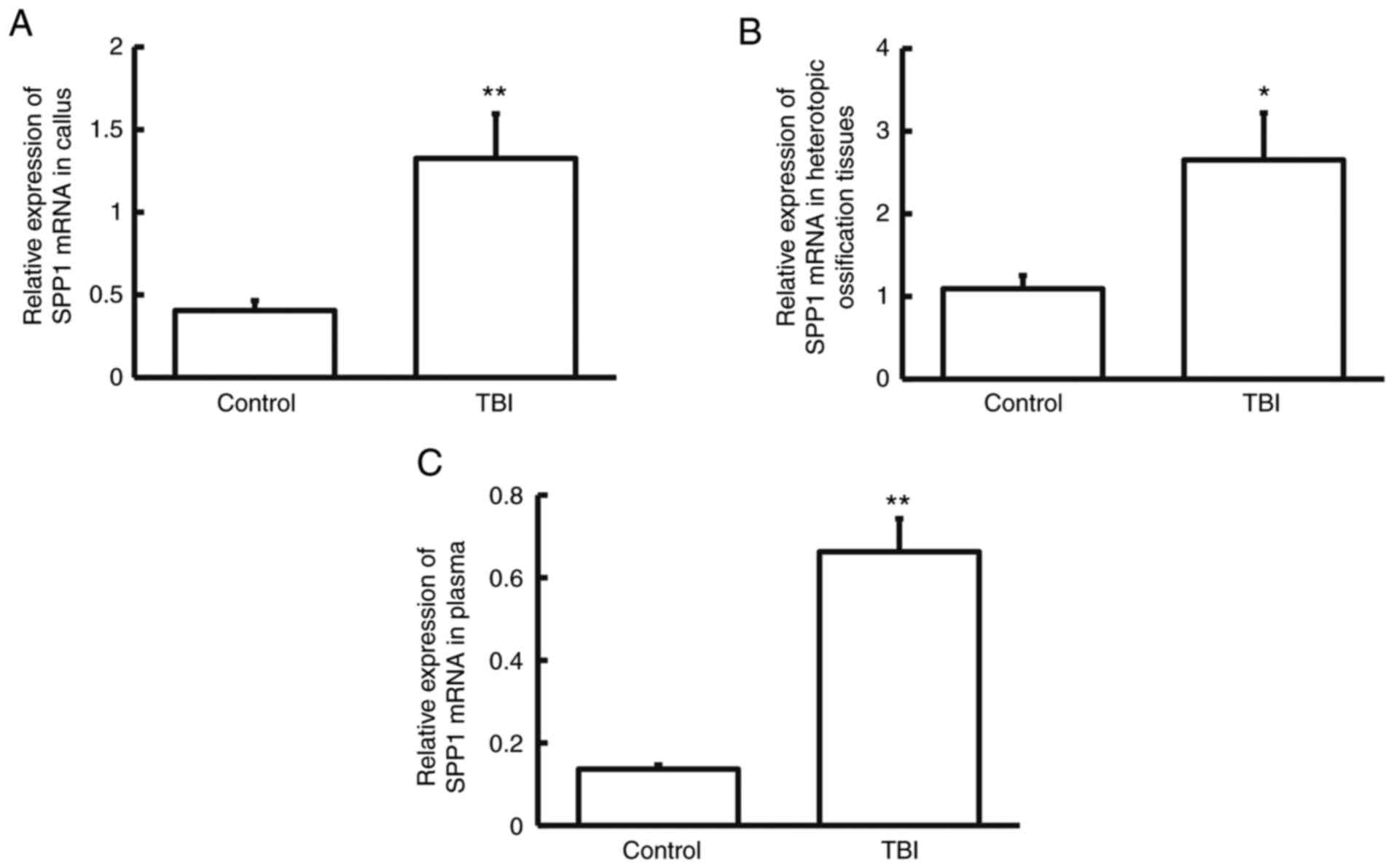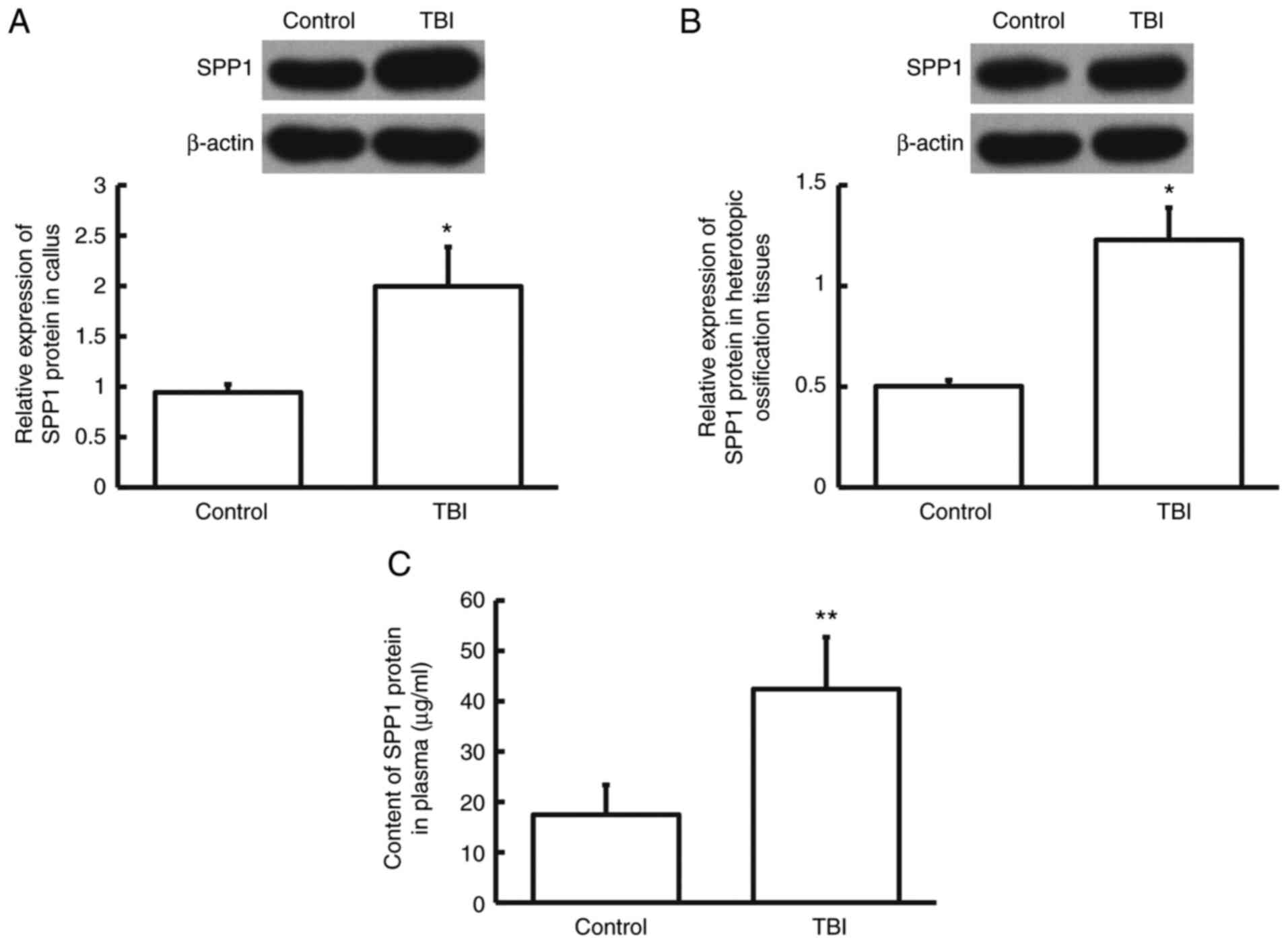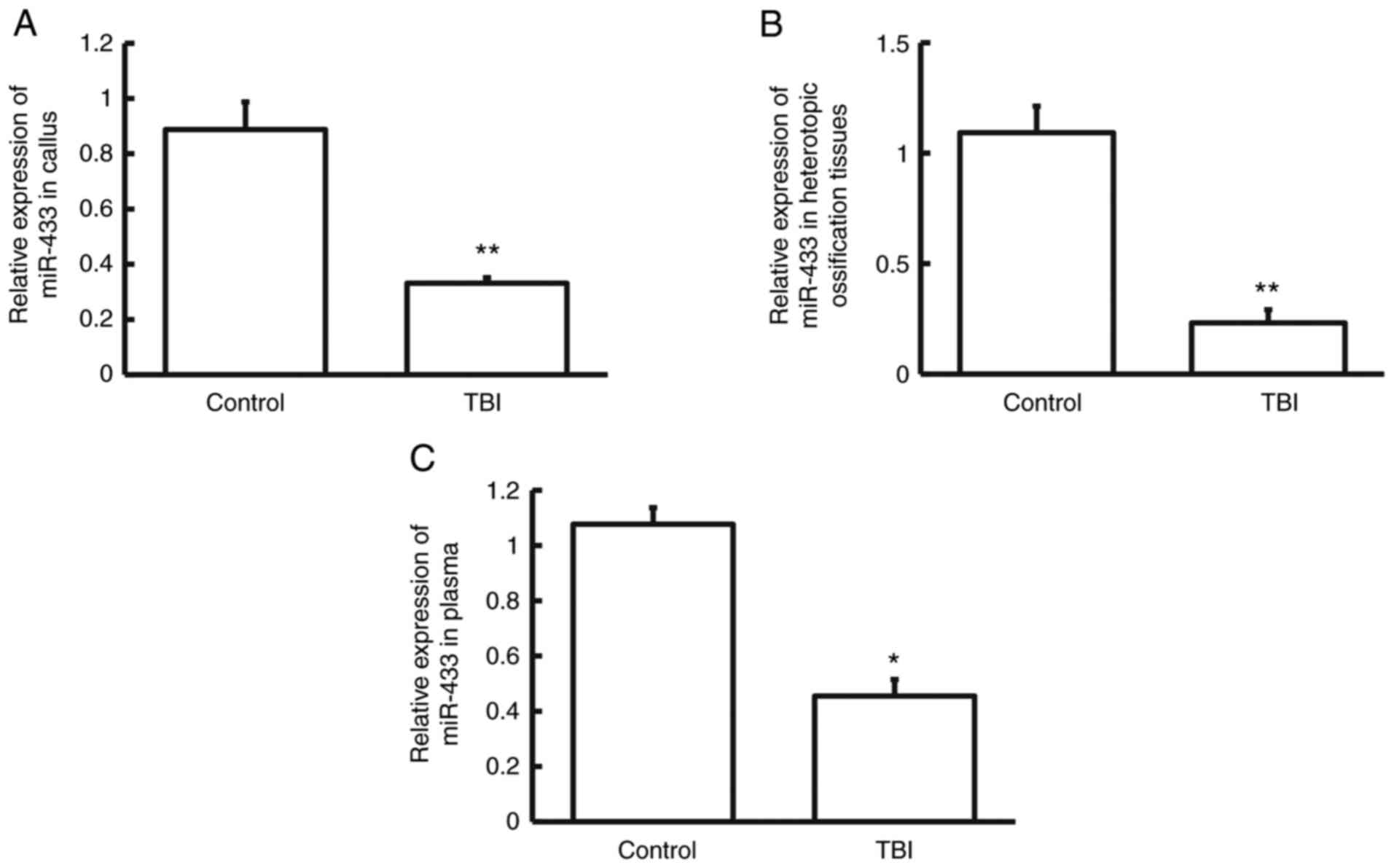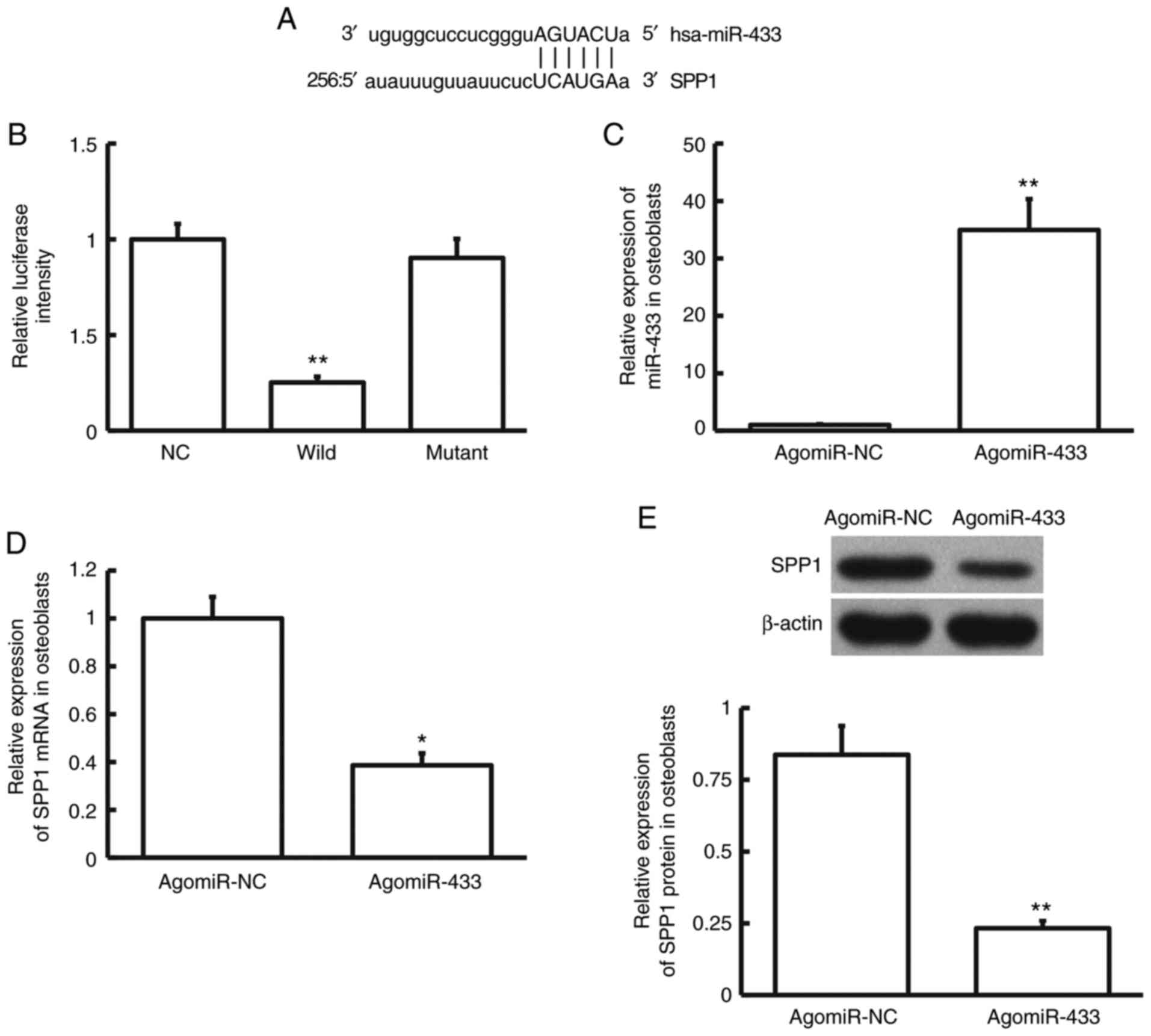|
1
|
Li Z, Zhao J, Luo W, Li K, Lei S and Wang
Y: Nrp-1 expression in healing process of traumatic brain injury
combined with tibial fracture. Zhong Nan Da Xue Xue Bao Yi Xue Ban.
42:154–160. 2017.PubMed/NCBI View Article : Google Scholar : (In Chinese).
|
|
2
|
Kobylecki C, Glasse H, Amin J, Gregson CL,
Lyell V and Henderson EJ: Fracture risk assessment in atypical
parkinsonian syndromes. Mov Disord Clin Pract. 8:385–389.
2021.PubMed/NCBI View Article : Google Scholar
|
|
3
|
Brady RD, Grills BL, Church JE, Walsh NC,
McDonald AC, Agoston DV, Sun M, O'Brien TJ, Shultz SR and McDonald
SJ: Closed head experimental traumatic brain injury increases size
and bone volume of callus in mice with concomitant tibial fracture.
Sci Rep. 6(34491)2016.PubMed/NCBI View Article : Google Scholar
|
|
4
|
Jodoin M, Rouleau DM, Therrien E, Chauny
JM, Sandman E, Larson-Dupuis C, Leduc S, Gosselin N and De Beaumont
L: Investigating the incidence and magnitude of heterotopic
ossification with and without joints involvement in patients with a
limb fracture and mild traumatic brain injury. Bone Rep.
11(100222)2019.PubMed/NCBI View Article : Google Scholar
|
|
5
|
Boes M, Kain M, Kakar S, Nicholls F,
Cullinane D, Gerstenfeld L, Einhorn TA and Tornetta P III:
Osteogenic effects of traumatic brain injury on experimental
fracture-healing. J Bone Joint Surg Am. 88:738–743. 2006.PubMed/NCBI View Article : Google Scholar
|
|
6
|
Pang X, Gong K, Zhang X, Wu S, Cui Y and
Qian BZ: Osteopontin as a multifaceted driver of bone metastasis
and drug resistance. Pharmacol Res. 144:235–244. 2019.PubMed/NCBI View Article : Google Scholar
|
|
7
|
Chen G, Zhang X, Li R, Fang L, Niu X,
Zheng Y, He D, Xu R and Zhang JZ: Role of osteopontin in synovial
Th17 differentiation in rheumatoid arthritis. Arthritis Rheum.
62:2900–2908. 2010.PubMed/NCBI View Article : Google Scholar
|
|
8
|
Gao SG, Li KH, Zeng KB, Tu M, Xu M and Lei
GH: Elevated osteopontin level of synovial fluid and articular
cartilage is associated with disease severity in knee
osteoarthritis patients. Osteoarthritis Cartilage. 18:82–87.
2010.PubMed/NCBI View Article : Google Scholar
|
|
9
|
Gattorno M, Gregorio A, Ferlito F, Gerloni
V, Parafioriti A, Felici E, Sala E, Gambini C, Picco P and Martini
A: Synovial expression of osteopontin correlates with angiogenesis
in juvenile idiopathic arthritis. Rheumatology (Oxford).
43:1091–1096. 2004.PubMed/NCBI View Article : Google Scholar
|
|
10
|
Song SZ, Lin S, Liu JN, Zhang MB, Du YT,
Zhang DD, Xu WH and Wang HB: Targeting of SPP1 by microRNA-340
inhibits gastric cancer cell epithelial-mesenchymal transition
through inhibition of the PI3K/AKT signaling pathway. J Cell
Physiol. 234:18587–18601. 2019.PubMed/NCBI View Article : Google Scholar
|
|
11
|
Yu H, Sun H, Wang Z and Liu Y: MicroRNA
let-7a up-regulates OPN expression in a mouse model of allergic
rhinitis. J Laryngol Otol. 131:955–960. 2017.PubMed/NCBI View Article : Google Scholar
|
|
12
|
Liu Y, Qian K, Li C, Ma Y and Chen X:
Roles of microRNA-539 and osteopontin in rheumatoid arthritis. Exp
Ther Med. 15:2681–2687. 2018.PubMed/NCBI View Article : Google Scholar
|
|
13
|
Jiang K, Teng GD and Chen YQ: MicroRNA-23
suppresses osteogenic differentiation of human bone marrow
mesenchymal stem cells by targeting the MEF2C-mediated MAPK
signaling pathway. J Gene Med. 22(e3216)2020.PubMed/NCBI View
Article : Google Scholar
|
|
14
|
Tao L, Bei Y, Chen P, Lei Z, Fu S, Zhang
H, Xu J, Che L, Chen X, Sluijter JP, et al: Crucial role of miR-433
in regulating cardiac fibrosis. Theranostics. 6:2068–2083.
2016.PubMed/NCBI View Article : Google Scholar
|
|
15
|
Zhang T, Jiang K, Zhu X, Zhao G, Wu H,
Deng G and Qiu C: miR-433 inhibits breast cancer cell growth via
the MAPK signaling pathway by targeting Rap1a. Int J Biol Sci.
14:622–632. 2018.PubMed/NCBI View Article : Google Scholar
|
|
16
|
Shi Q, Wang Y, Mu Y, Wang X and Fan Q:
MiR-433-3p inhibits proliferation and invasion of esophageal
squamous cell carcinoma by targeting GRB2. Cell Physiol Biochem.
46:2187–2196. 2018.PubMed/NCBI View Article : Google Scholar
|
|
17
|
Sun S, Wang X, Xu X, Di H, Du J, Xu B,
Wang Q and Wang J: MiR-433-3p suppresses cell growth and enhances
chemosensitivity by targeting CREB in human glioma. Oncotarget.
8:5057–5068. 2017.PubMed/NCBI View Article : Google Scholar
|
|
18
|
Rolfs F, Piersma SR, Dias MP, Jonkers J
and Jimenez CR: Feasibility of phosphoproteomics on leftover
samples after RNA extraction with guanidinium thiocyanate. Mol Cell
Proteomics. 20(100078)2021.PubMed/NCBI View Article : Google Scholar
|
|
19
|
Livak KJ and Schmittgen TD: Analysis of
relative gene expression data using real-time quantitative PCR and
the 2(-Delta Delta C(T)) method. Methods. 25:402–408.
2001.PubMed/NCBI View Article : Google Scholar
|
|
20
|
Zhao D, Chen H and Wang B: Assessing the
regulatory functions of LncRNA SNHG11 in gastric cancer cell
proliferation and migration. Front Cell Dev Biol.
9(620476)2021.PubMed/NCBI View Article : Google Scholar
|
|
21
|
Einhorn TA and Gerstenfeld LC: Fracture
healing: Mechanisms and interventions. Nat Rev Rheumatol. 11:45–54.
2015.PubMed/NCBI View Article : Google Scholar
|
|
22
|
Dey D, Wheatley BM, Cholok D, Agarwal S,
Yu PB, Levi B and Davis TA: The traumatic bone: Trauma-induced
heterotopic ossification. Transl Res. 186:95–111. 2017.PubMed/NCBI View Article : Google Scholar
|
|
23
|
Micha D, Voermans E, Eekhoff ME, van Essen
HW, Zandieh-Doulabi B, Netelenbos C, Rustemeyer T, Sistermans EA,
Pals G and Bravenboer N: Inhibition of TGFβ signaling decreases
osteogenic differentiation of fibrodysplasia ossificans progressiva
fibroblasts in a novel in vitro model of the disease. Bone.
84:169–180. 2016.PubMed/NCBI View Article : Google Scholar
|
|
24
|
Lin YH and Yang-Yen HF: The
osteopontin-CD44 survival signal involves activation of the
phosphatidylinositol 3-kinase/Akt signaling pathway. J Biol Chem.
276:46024–46030. 2001.PubMed/NCBI View Article : Google Scholar
|
|
25
|
Wang KX and Denhardt DT: Osteopontin: Role
in immune regulation and stress responses. Cytokine Growth Factor
Rev. 19:333–345. 2008.PubMed/NCBI View Article : Google Scholar
|
|
26
|
Shao H, Wu R, Cao L, Gu H and Chai F:
Trelagliptin stimulates osteoblastic differentiation by increasing
runt-related transcription factor 2 (RUNX2): A therapeutic
implication in osteoporosis. Bioengineered. 12:960–968.
2021.PubMed/NCBI View Article : Google Scholar
|
|
27
|
Wang J, Gao Z and Gao P: MiR-133b
modulates the osteoblast differentiation to prevent osteoporosis
via targeting GNB4. Biochem Genet, Mar 9, 2021 (Online ahead of
print).
|
|
28
|
He HP and Gu S: The
PPAR-γ/SFRP5/Wnt/β-catenin signal axis regulates the
dexamethasone-induced osteoporosis. Cytokine.
143(155488)2021.PubMed/NCBI View Article : Google Scholar
|
|
29
|
Foster BL, Ao M, Salmon CR, Chavez MB,
Kolli TN, Tran AB, Chu EY, Kantovitz KR, Yadav M, Narisawa S, et
al: Osteopontin regulates dentin and alveolar bone development and
mineralization. Bone. 107:196–207. 2018.PubMed/NCBI View Article : Google Scholar
|
|
30
|
Ma C, Wei F, Xia H, Liu H, Dong X, Zhang
Y, Luo Q, Liu Y and Li Y: MicroRNA-10b mediates TGF-β1-regulated
glioblastoma proliferation, migration and epithelial-mesenchymal
transition. Int J Oncol. 50:1739–1748. 2017.PubMed/NCBI View Article : Google Scholar
|
|
31
|
Zhao X, Mohan R, Özcan S and Tang X:
MicroRNA-30d induces insulin transcription factor MafA and insulin
production by targeting mitogen-activated protein 4 kinase 4
(MAP4K4) in pancreatic β-cells. J Biol Chem. 287:31155–31164.
2012.PubMed/NCBI View Article : Google Scholar
|
|
32
|
Chen K and Rajewsky N: The evolution of
gene regulation by transcription factors and microRNAs. Nat Rev
Genet. 8:93–103. 2007.PubMed/NCBI View
Article : Google Scholar
|
|
33
|
Li J, Chen M and Yu B: miR-433 suppresses
tumor progression via Smad2 in non-small cell lung cancer. Pathol
Res Pract. 215(152591)2019.PubMed/NCBI View Article : Google Scholar
|
|
34
|
Zhao YF, Li MX, Chang GZ and He XH: ERK on
apoptosis of gastric cancer cells induced by microRNA-433. Zhonghua
Yi Xue Za Zhi. 98:3954–3957. 2018.PubMed/NCBI View Article : Google Scholar : (In Chinese).
|
|
35
|
Liang T, Guo Q, Li L, Cheng Y, Ren C and
Zhang G: MicroRNA-433 inhibits migration and invasion of ovarian
cancer cells via targeting Notch1. Neoplasma. 63:696–704.
2016.PubMed/NCBI View Article : Google Scholar
|
|
36
|
Yang Z, Tsuchiya H, Zhang Y, Hartnett ME
and Wang L: MicroRNA-433 inhibits liver cancer cell migration by
repressing the protein expression and function of cAMP response
element-binding protein. J Biol Chem. 288:28893–28899.
2013.PubMed/NCBI View Article : Google Scholar
|
|
37
|
Guo LH, Li H, Wang F, Yu J and He JS: The
tumor suppressor roles of miR-433 and miR-127 in gastric cancer.
Int J Mol Sci. 14:14171–14184. 2013.PubMed/NCBI View Article : Google Scholar
|
|
38
|
Lin X, Rice KL, Buzzai M, Hexner E, Costa
FF, Kilpivaara O, Mullally A, Soares MB, Ebert BL, Levine R and
Licht JD: miR-433 is aberrantly expressed in myeloproliferative
neoplasms and suppresses hematopoietic cell growth and
differentiation. Leukemia. 27:344–352. 2013.PubMed/NCBI View Article : Google Scholar
|
|
39
|
Tang X, Lin J, Wang G and Lu J:
MicroRNA-433-3p promotes osteoblast differentiation through
targeting DKK1 expression. PLoS One. 12(e0179860)2017.PubMed/NCBI View Article : Google Scholar
|
|
40
|
Kim EJ, Kang IH, Lee JW, Jang WG and Koh
JT: MiR-433 mediates ERRγ-suppressed osteoblast differentiation via
direct targeting to Runx2 mRNA in C3H10T1/2 cells. Life Sci.
92:562–568. 2013.PubMed/NCBI View Article : Google Scholar
|
|
41
|
Smith SS, Dole NS, Franceschetti T,
Hrdlicka HC and Delany AM: MicroRNA-433 dampens glucocorticoid
receptor signaling, impacting circadian rhythm and osteoblastic
gene expression. J Biol Chem. 291:21717–21728. 2016.PubMed/NCBI View Article : Google Scholar
|
|
42
|
Simon D, Laloo B, Barillot M, Barnetche T,
Blanchard C, Rooryck C, Marche M, Burgelin I, Coupry I, Chassaing
N, et al: A mutation in the 3'-UTR of the HDAC6 gene abolishing the
post-transcriptional regulation mediated by hsa-miR-433 is linked
to a new form of dominant X-linked chondrodysplasia. Hum Mol Genet.
19:2015–2027. 2010.PubMed/NCBI View Article : Google Scholar
|
|
43
|
Wang P and Zhang Z: Bone marrow-derived
mesenchymal stem cells promote healing of rabbit tibial fractures
via JAK-STAT signaling pathway. Exp Ther Med. 19:2310–2316.
2020.PubMed/NCBI View Article : Google Scholar
|
|
44
|
Liu S, Huang Y, Tian S, Zhang W, Xu Y and
Ge J: Hyperhomocysteinemia inhibits tibial fracture healing in rats
through PI3K/AKT signaling pathway. Exp Ther Med. 19:2083–2088.
2020.PubMed/NCBI View Article : Google Scholar
|
|
45
|
Qiao J, Zhou M, Li Z, Ren J, Gao G, Cao G,
Shen H and Lu S: Comparison of remote ischemic preconditioning and
intermittent hypoxia training in fracture healing. Mol Med Rep.
19:1867–1874. 2019.PubMed/NCBI View Article : Google Scholar
|















